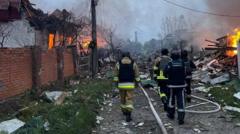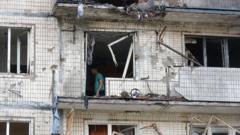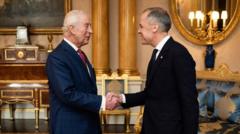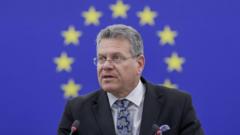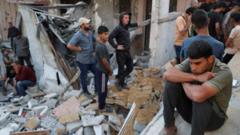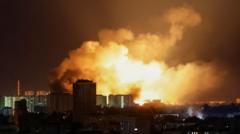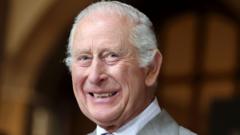Recent diplomatic engagements, including statements from President Putin and discussions with Donald Trump, have left Russia bolstered in its stance, yet genuine progress toward peace in Ukraine appears elusive. Despite ongoing conflict and negotiations, the Kremlin's approach raises questions about the future of relations and territorial claims.
Kremlin's Diplomacy Dance: Russia's Bold Moves Amidst Ukraine Conflict
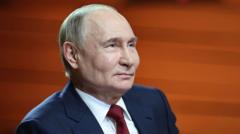
Kremlin's Diplomacy Dance: Russia's Bold Moves Amidst Ukraine Conflict
A tumultuous fortnight reveals Russia's confidence and strategic sidestepping in the ongoing Ukraine peace dialogue, while the prospects for actual resolution seem bleak.
Inside the Kremlin walls, the atmosphere is thick with intrigue—especially as night deepens and confusion sets in. I found myself wandering through the vast and historic expanse, desperately attempting to find my way out after attending an event meant to include a question-and-answer session with President Putin. Instead, the evening unraveled differently. Putin took to Russian television to announce a proposal for direct peace talks with Ukraine in Istanbul, without any prior exchange with the press.
The past two weeks have taken a dizzying turn since that night, encompassing peace negotiations in Turkey and a subsequent two-hour phone call between Putin and Donald Trump. But when stepping back from the whirlwind, the question emerges: are we any closer to peace in Ukraine? The feeling is that we remain far from resolution.
Discussions of future talks, and even potential memorandums on peace agreements, feel ambiguous at best. Fighting in Ukraine persists, with Russia firmly rejecting the idea of an unconditional comprehensive ceasefire. Instead, Moscow appears resolute in its claims to Ukrainian territory, implying a desire for expansion rather than compromise, leaving the peace process shrouded in uncertainty—much like being lost within the Kremlin.
Analyzing these past two weeks offers insight into the Kremlin's strategy—one that some critics might term a game of procrastination. Just prior to my mistaken stroll within the Kremlin grounds, European leaders had delivered an ultimatum to Putin: agree to a long-term ceasefire within 48 hours or face rigorous new sanctions. While Ukraine complied with the call for a ceasefire, Russia chose to deflect the ultimatum, introducing a counterproposal for direct talks in Turkey that managed to appease Trump.
The Istanbul meeting, which occurred on May 16, drew skepticism from many, yet resulted in a perceived diplomatic success for Trump, one that curbed any immediate threats of sanctions. Trump's indication that Putin may attend was ultimately unfounded as Russia sent a lesser delegation to the talks, who promptly rejected a long-term ceasefire. Trump communicated that Russia and Ukraine would initiate negotiations for an end to hostilities; however, Moscow remained noncommittal on any peace agreement, consistent with its ongoing attempts to undermine the legitimacy of the Ukrainian president, Volodymyr Zelensky.
Views among Russian media outlets following these diplomatic forays tended towards triumph, with claims of Russia emerging victorious in this new geopolitical chess game. Reports noted that Trump has inadvertently supported Moscow's demand for more discussion before considering a ceasefire, creating a divide between the U.S. and Europe.
Despite Trump’s earlier eagerness to mediate the situation, tangible progress has been slow. While he has occasionally criticized Russian actions, he remains hesitant to impose stronger measures. Communiqué from Trump’s administration has implied that initiating dialogue with Russia is independent of the Ukraine situation, which has given the Kremlin a boost of confidence, allowing them to navigate pressures with relative ease.
However, the potential for new sanctions looms over Moscow, as U.S. congressional threats to implement these measures remain. Russia's ongoing ambivalence about Ukraine's territorial integrity casts a long shadow on any hopeful dialogues, while the Kremlin's belief in its fortified position allows for continued sidestepping and delaying tactics.
As we move forward, the diplomatic landscape continues to shift; yet, the exit seems obscured as the complexities of war and negotiation unfold.

